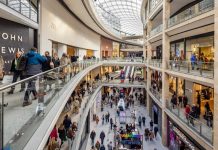Whilst retail sales have turned negative in much of Europe, Asia continues to enjoy strong growth, with robust consumer demand sustained in a wide range of markets and more retailers inevitably turning their eyes eastwards as a result.
Mark Burlton, Head of EMEA Cross-border Retail at Cushman & Wakefield, “As more and more Western economies have stagnated or worse, retailers have been seeking to expand into Asia and more specifically into China.”
China reported retail sales growth of 17.7% in September following a 17% gain in August, and this in a period when there was more uncertainty and volatility in world markets than at any time since the global financial crisis in 2008. For China, this growth has been particularly apparent at the luxury end of the market with retailers such as Burberry and Richemont disclosing the importance of China as a driver of recent growth while others such as Swatch, PPR and LVMH have all reported strong third quarter sales spurred by increased demand in Asia as a whole.
For China and the region it is not just a story of luxury though, with retailers such as Hennes & Mauritz stepping up expansion in Asia while Esprit is targeting strong growth in China, as is Gap, even as it is closing stores in North America. However, while a growing number of major international brands are turning their attention towards China as well as other Asian cities, they will face competition from the growing Asian brands expanding across the region, such as Fast Retailing, which is targeting 2,000 openings for its Uniqlo brand, half of which will be in China.
“Internationalization has been a growing theme in the retail market for some time but the age of global retailing and global retailers is really now approaching and the flow of international retailers not just into Asia but between Asia, Europe and rest of the world is set to grow rapidly as brands seek to diversify into new markets which provide exciting potential for revenue growth,” concluded Burlton.
According to John Stinson, Head of Capital Markets for Asia Pacific at Cushman & Wakefield “Economic conditions may be challenging in many parts of the world and Asia is not without its share of problems, however the fundamentals still point to strong growth potential in the region, particularly in China. Currently retail sales make up only around 25% of China’s GDP while according to ICSC, retail makes up 70% of US GDP. Countries such as China and India with large populations and growing incomes are capable of harnessing an increasing level of retail demand. Within a decade some are forecasting that China’s retail scale could surpass that of the European Union and the US to become highest retail turnover market in the world.”
In the large tier 1 cities of Shanghai and Beijing strong retail leasing activity continues. Kerry Parkside in Pudong, which opened last month, attracted international brands such as Gap, Muji and H&M while in traditional high volume retail locations demand is also strong, with Apple opening a 2,500 sqm store on East Nanjing Road in Shanghai for example.
Activity is not limited to the Tier 1 cities however. Chengdu is a good example of a Tier 2 city in the west experiencing strong growth. At the end of June retail sales for the first half reached US$21bn up 18.4 % from last year. Brands such as Tommy Hilfiger, Lacoste and Guess leased space in Vans Department Store and high-end brands such as Dior Kids, Hugo Boss Kids, Giorgio Armani cosmetics, Penny Black, Max & Co and Boss Orange all entered Chengdu Pacific Department Store. Luxury brands are also focusing on this market, with Italian jewelry brand Damiani opening its first store at Chengdu Mansion Mode and Karine Arabian opening its second store in Yanlord Landmark for example.
The establishment of these brands in the Chengdu market is backed by strong turnover from existing players. Ferragamo in Maison Mode was reported to have sales volumes in the top ten for the brand worldwide. “With strong growth in disposable income together with fast paced development of luxury brand malls, we anticipate enormous potential for this market” commented Stinson.
Investment sentiment has followed the strong growth in retail turnover throughout Asia and particularly in China. “While much of the world saw volatile and falling sales over the autumn, Asian retail has bucked the trend” said Stinson. “Retail investment volumes grew 13 % from mid-year and year to date volumes across the region now stand at US$18.3 bn, surpassing the entire 2010 figure of US$17.4 bn”.
Of the total YTD volume, US$6.35 bn was transacted in China, up from US$4.18bn in 2010. “The retail sector is the hottest investment sector in Asia at present and is particularly popular with cross border investors. 50% of the total transaction volume was generated by foreign buyers. Increasingly, investors from within the region have been the most aggressive. 80% of foreign acquisitions occurring in China and Hong Kong were acquired by Hong Kong and Singapore buyers for example. Capitamall acquired 2 malls in Shanghai for over US$1.6bn whilst Mapletree acquired Festival walk in Hong Kong for US$2.4 bn” stated Stinson.
The outlook for 2012 is positive. Notwithstanding the potential for economic headwinds from Europe and the U.S. to hit the region, average regional growth is still forecast at 6 to 7% which will be enough to sustain and grow employment and incomes. The region’s big powerhouses of China and India may see somewhat slower growth but at a forecast 8% to 9% they will still be significantly ahead of other parts of the globe and will continue to have a strong multiplier effect domestically and throughout the entire region.



















